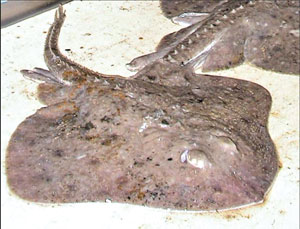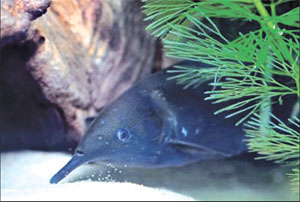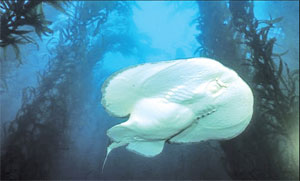|
 Nature
trail: Nature
trail:
Powerful electric generators
Electricity is a powerful force with the ability to kill. In our
day-to-day lives we use and depend on electricity to do many things. We
are so focused on these electrical objects we deal with on a daily basis
that we hardly pay attention to the powerful electrical forces of nature
around us, except maybe lightning which flashes before our eyes whenever
there is a thunderstorm.
However, electrical forces are everywhere, even in humans and
animals. Today we want to enlighten you about some underwater creatures
that have the ability to generate enough electricity to kill their prey.
There are many kinds of fish with the capability of generating
electricity, but they all do not do so just to kill prey. Some creatures
produce electricity for less violent purposes such as navigation. Isn’t
it fascinating that these creatures could produce electricity? How are
they able to do so? Let’s find out.
Different fish generate electricity using organs modified from
different muscles in their bodies. But the method used to generate
electricity is the same.
A fish’s electric organs are composed of electro plaques, which are
flattened cells arranged in vertical columns similar to a pile of coins.
And even though each of these columns of electro plaques generate
very little electricity – as little as 0.1 volt, the overall charge
becomes very powerful since the columns are linked together.
Water is said to be a good conductor of electricity. Seawater is a
better conductor than freshwater, therefore, salt water species of
electric fish do not need to generate high voltages like their
freshwater counterparts to produce the same current.
|

Rajid skate |
|

Electric eel |
|

Electric catfish |
|

Stargazer |
Electric fish living in freshwater habitats are able to overcome the
inherent (existing) resistance of freshwater because they have much
taller columns of electro plaques than marine species of electric fish.
Out of all the electric fish, the most potent (powerful) marine
species is the electric ray which is also known as the torpedo ray.
This species is found in the Mediterranean and the subtropical
Atlantic seas. A large electric ray can generate up to 200 volts of
electricity to stun or kill its prey. The torpedo rays high-voltage
blast comes from a pair of electrical organs located in its huge, round
pectoral fin which is just behind each eye.
|

Mormyrid |
|

Torpedo ray |
|

Gymnotid |
The torpedo rays ability to generate electricity was known even
during ancient Greek and Roman times.
Would you believe that some ancient Roman physicians used the
electric charge to cure patients suffering from severe headaches and
gout by strapping a living torpedo ray to the patient’s head?
Two other fish that pack a punch that is literally shocking (but much
weaker in voltage to that of the ray) are bottom-dwelling marine rajid
skates and electric stargazers.
The electric organs of the rajid skates are located in their tails
while those of the electric stargazers in the West Atlantic, are located
in deep pits, also behind the eyes like in the rays.
The stargazer fish uses its electric organs to stun prey as well as
to defend itself from predators.
It generally hides deep in the sand with only its eyes protruding
waiting for prey to pass by and stuns the victim as it goes by.
There are more marine fish that generate electricity in weaker
voltages than other than the rays.
Among the freshwater species that produces the most powerful
electrical discharge of all, the Amazon electric eel ranks at the top.
Measuring up to 3-metre (10 ft), the eel has three electric organs. It
uses two of these for navigation and prey detection.
The third organ which is its most formidable weapon is used to stun
prey.The third organ is split into two long, lateral halves and it
discharges up to 550 volts out of its tail into its freshwater
habitat.The powerful blast can not only stun its prey such as fishes and
frogs, but also kill humans and horses if they happen to be in the water
when it’s discharged.
Like the mighty electric eel Africa’s freshwater electric catfish can
also produce a discharge up to 350 volts from an electric organ which
surrounds its body. Like the eel, it also uses the electric voltage jolt
to stun prey as well as to ward off would be attackers.
Two other fish that have electric organs are the mormyrids and knife
fish gymnotids. They however use their electric organs to navigate not
to stun predators or prey.
How exactly do they use electric organs to navigate?
As the fish swims, these organs create an electrical force field that
surrounds it, and is modified by the relative conductivity of objects in
the fish’s immediate surroundings.
The fish is able to detect and interpret these electric fluctuations
(changes) through electro receptors embedded in its body.
So, it has the ability to effectively navigate itself around
obstacles even in the darkest water due to the constantly changing
electrical image.
It can also sense nearby prey and any objects coming its way.Read
more about the creatures that have the ability to generate electricity
and find out how powerful they are .
Fact file
* The electric eel (Electrophorus electricus) has an elongated,
cylindrical body. Despite its name, the electrceel is not closely
related to true eels (Anguilliformes), but is a member of the
neotropical knifefishes (Gymnotiformes), more closely related to
catfishes.
* Electric eels feed on invertebrates, although adult eels may also
consume fish and small mammals. First-born hatchlings will eat other
eggs and embryos from later batches.The juveniles will eat
invertebrates, such as shrimps or crabs.
* The electric eel is known for its unusual breeding behavior. In the
dry season, a male eel makes a nest from his saliva into which the
female lays her eggs. As many as 3,000 young will hatch from the eggs in
one nest. Male electric eels are much smaller than the females.
* Commonly known as electric rays, torpedo rays, or torpedoes these
powerful creatures are bottom-dwellers capable of generating electricity
as a defense and feeding mechanism. There are between fifteen and
twenty-two extant species.The largest species is the Atlantic torpedo.
* The naval weapon known as the torpedo was named after this genus,
whose own name is derived from the Latin word meaning “numb” or
“paralysed” presumably the sensation one would feel after experiencing
the ray’s electric shock.
* Electric stargazer has eyes on top of its head and that is why it
is so named The family includes about 51 species (one extinct) in eight
genera, all marine . It is and found worldwide in shallow waters. In
addition to the top-mounted eyes, a stargazer also hase a large
upward-facing mouth in a large head.Its electric organ consists of
modified eye muscles. It is one of the few marine bony fishes tha tis
electrogenic. The stargazer is unique among electric fish in not
possessing specialized electroreceptors. |



